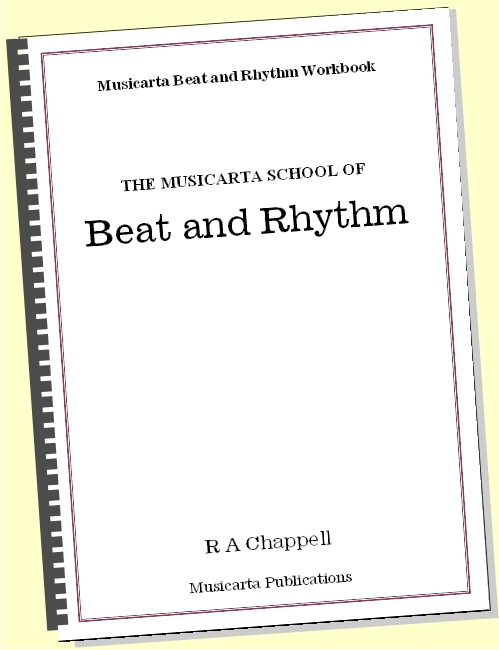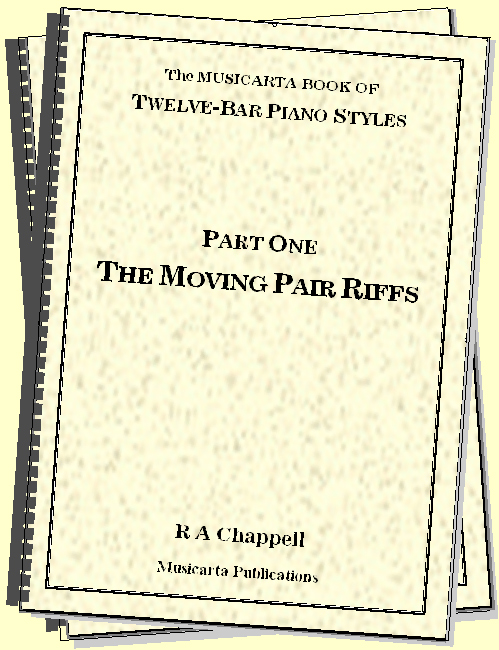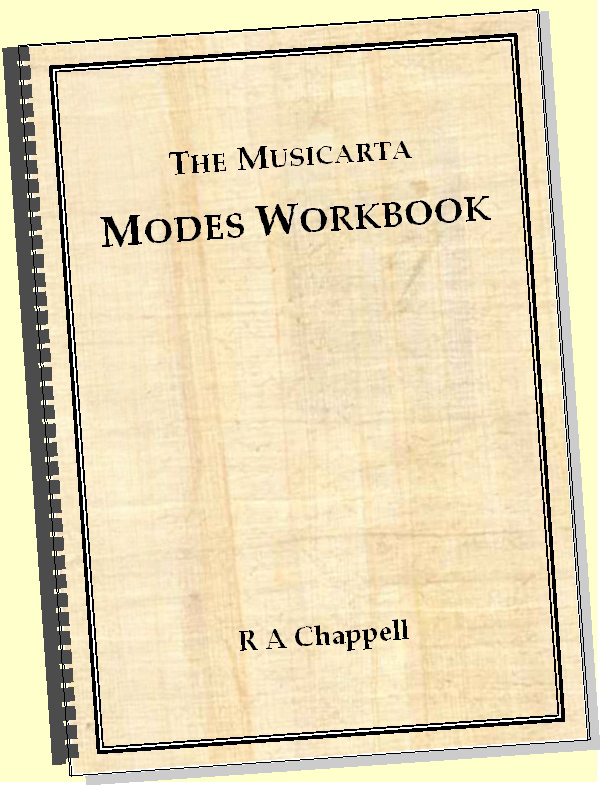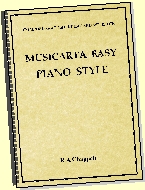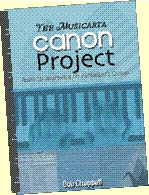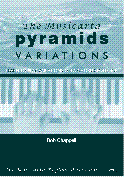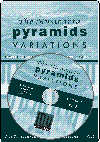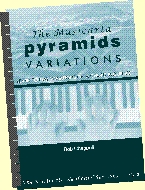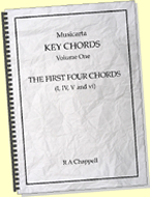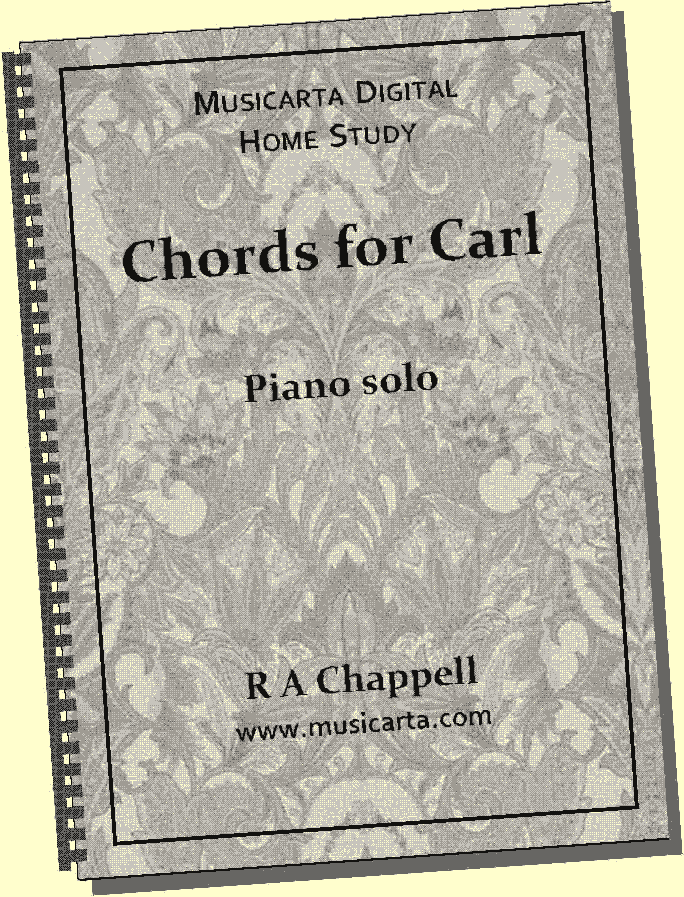Piano Keyboard Lessons
Memorising Pyramids
A good curriculum of piano keyboard lessons should always have a memorising element. If we don’t bother to memorise, we stay ‘slave to the dots’ (or anxious when there aren’t any) when we should be enjoying the full flight of our artistic imaginations.
The Musicarta Pyramids Variations series of keyboard creativity lessons has been released as an e-book digital download/data-CD. Click through to the Pyramids Variations home page to learn more, or jump right in and . . .
|
|
BUY THE DIGITAL DOWNLOAD only $14.95

|
|
TAKE THE
DATA-CD
OPTION
only $12.95
COMING SOON!
|
These pared-down web pages have been left on the site to show you how the Pyramids Variations will give your repertoire and keyboard know-how a massive boost – explore them using the series navigation in the right hand column. Enjoy!
|
In Greek mythology, the nine Muses - the maidens who inspire artists to great creation - were the daughters of Zeus and Mnemosyne - memory. So "Memory is the mother of the muses," and true artists apply memory skills methodically to their craft. Use the techniques in this module to make a habit of memorising your pieces, and stay ahead of the pack!
Piano Keyboard Lessons - Memorising is one of the modules of The Pyramids Variations, a series of free online piano lessons form Musicarta.com. To understand and profit from it, you need to have started studying the series. Please visit the
Pyramids Variations home page
for an introduction to the series, or go to the
Musicarta.com home page
for other free piano keyboard lessons.<
Memorising the Pyramids Variations
Studying the Pyramids Variations piano keyboard lessons helps pianists and keyboard players learn how to improvise. Knowing the underlying chord sequence by heart makes improvising a lot easier – worrying about what chord comes next distracts you from the business of making music. You will also play without delays and enjoy yourself a lot more if you are sure of the chord sequence.
There are four memory mini-modules on this page:
You should study them all carefully. They are all techniques you can adapt to learning any piece of music.
Re-visit this module whenever you need to. If you stumble or delay at the same place in a piece of music more than once or twice, your memory is probably as much to blame as your fingers!
It you’re working on your own, you have to be extra vigilant. It’s very easy to ignore your own delays. Use a metronome if you have one – but set it at a realistic speed for what you’re trying to do. MM = 56 gives a slow "ONE-and-a TWO-and-a" speed to start at.
A note: Practice efficiently. Just playing through a piece isn't the same as learning it. You have to make a special kind of effort to learn a piece. If you always trip yourself up in the same place, study just that part to find out what it is that you aren’t sure of. Don’t go back to the beginning and take a run at it – music isn’t like the long jump or a pole vault!
All the chords used in the build-up to the Concert Performance are Basic Music-making Position chords with the root (the name-note) at the bottom. (Technically, they are 'triads in root position'.) So if you learn the bass line – the line the roots of the chords make – you learn the chord sequence as well.

This one-line study squeezes all 16 bars of Pyramids into one line of music. It helps you see and rehearse the zigzag shape the roots make when you play the 16-bar chord sequence.
Play the study using just your first (pointing) fingers. Using the same finger for all the notes makes you more aware of the size and direction of the jumps.
You don’t even have to read the music – the notes you play are the notes named by the chord symbol. Here they are, shown on a keyboard:

Singing to help memorise music
When you’re learning or memorising a piece of music, it helps to sing along. You don’t have to be able to sing well – the singing just involves a different part of your brain. In the case of the Pyramids bass line, singing is another way of thinking about the overall shape.
Also, you can hear in your voice when you don’t know the music – your voice wavers, or you just can’t sing the note. Either way, you know you need to go back and study that particular part.
So sing or hum along as you play through the bass line (above).
Using the shape of the bass line to help you
Here is the zigzag line the bass notes make, squashed and stretched so that you can see its shape more clearly:

Different people remember things in different ways, and good piano keyboard lessons should take account of this. You might find the following activities in particular helps you memorise the bass line, and thus the chord sequence.
-
Trace the zigzag shape of the bass line with your finger. Memorise the shape, then draw it from memory in the air with your eyes closed
-
Draw the zigzag bass line in your mind’s eye (with your eyes closed) as you hum the bass line to yourself. Are there any parts where you get stuck – that you don’t know so well?
Play the bass line with your index fingers again, observing how the sound has the same ‘shape’ as the zigzag bass line.
Sing the bass line from memory while looking at the line diagram.
In this section, the roots are arranged vertically (as a ‘ladder’) with the highest note A at the top and the lowest E at the bottom, so what is higher up on the page is a higher note too.
Then, arrowed lines shows the movement of the roots in the first and second halves of a 16-bar Pyramids version.
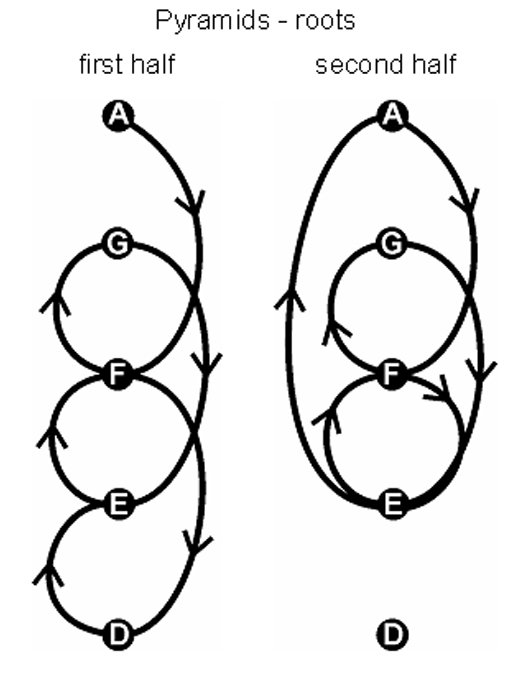
Check that you can see how the arrowed lines follow the roots:

The arrowed lines therefore accurately represent:

To help you memorise the chord sequence, copy the ‘blank’ diagram below and tap the roots with your finger as you sing or hum the bass line tune to yourself. You don’t actually have to follow the curly shape in the diagram above, because your finger can come off the page. Just be sure you tap the dots in order.

Here are the roots in text to help you:

After a few goes with your eyes open, do the exercise with your eyes closed. Sing or hum the bass line and tap the piece of paper where you think the dots are - or poke the air in front of you where you think the dots would be.
You won’t know exactly where the dots are, but make as sure as possible that your third bass note ‘G’ is halfway between your ‘A’ and your ‘F’, for example, and that you jump over the imaginary ‘F’ to get to ‘E’.
Pay especial attention to the last three bass notes of each half:

Two halves with different endings
Experience shows that if you are clear about how the two halves end differently, you probably know the chord sequence of the 16-bar Pyramids versions.
Look at the shape of the line the roots make:


If we place the first-half shape (bars 1 to 8) above the second-half shape (bars 9 to 16), we can see that both halves are the same as far as the second F chord:
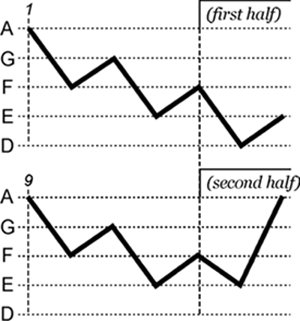
Only the endings of the lines are different.
-
The last three chords of the first half are F, Dm, E
The last three chords of the second half are F, E, Am
(A lot of Pyramids pupils play the first half twice instead of the first half then the second half.)

A very useful and effective exercise is to play the two different endings over and over, as you say or sing out loud exactly what it is you are trying to learn.
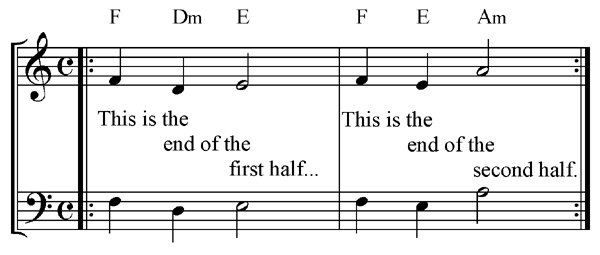
Alternatively, sing along with “F, D minor, E; F, E, A minor.” If you still need to remind yourself that that's an E major chord, say "E major" in full.
Here’s the chord sequence table for the 16-bar A1A2 version of Pyramids, with the ends of the first and second halves highlighted.

The more ways you have of looking at a piece of music, the easier it is to learn and remember it. Steps, skips and jumps offers another way of looking at musical shape.
In Pyramids, the roots of the chords move three different distances:
STEP – to the next-door white key, either up (right) or down (left)
SKIP – over the next-door key to the one beyond
JUMP – over more than one white key (bigger than a skip)
Here’s a chord chart showing the distance the Pyramids bass moves between notes. Read through to make sure you understand and check that the table is accurate.
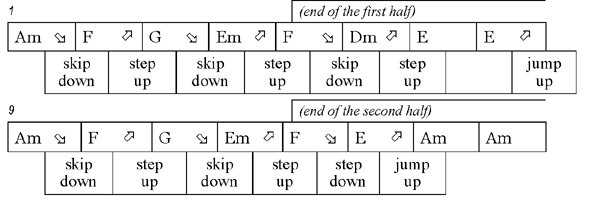
Here's a table showing just the step, skip, jump movements

Here is the zigzag Pyramids bass line shape marked with steps, skips and jumps:

Here is the roots ladder with the size of the movements marked.
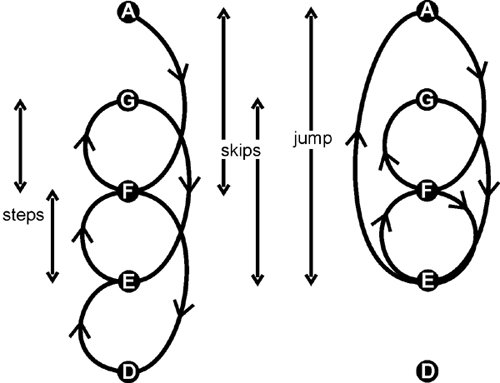
All three diagrams above show the same thing.
Now listen to the bass line and see if you can hear the step, skip, jump distances.
Remember that the step, skip, jumps given are distances between notes - you can't hear the the skip down from first note A to second note F until the second has played (unless you hear it in your head in advance).
Here are some more activities to do which will cement your mental image of the bass line and thus the chord sequence.
Work through the material making sure you can see how the skips, steps and jumps shown in the table match the distances shown in the line and ladder diagrams.
Copy one of the zigzag line diagrams from Pyramids and mark it up with ‘step’, ‘skip’ and ‘jump’.
Listen to the bass line audio clip and describe the movement of the bass line to yourself in words – when it moves down and when up, and by how much.
Play the bass line calling out whether the movement is a step, a skip or a jump.
Sing the bass line naming the sizes of the movements. Sing: “A, down a skip (F), up a step (G), down a skip (E)…” and so on to the end.
The full ‘lyrics’ for this are:
“A, down a skip (F), up a step (G), down a skip (E), up a step (F), down a skip (D), up a step (E)…
“Up a jump (A), down a skip (F), up a step (G), down a skip (E), up a step (F), down a step (E), up a jump (A).”
These are quite strange activities - but they work!
Of course, step, skip, jump analysis applies to the melody line as well. You need a ‘stays same’ category for the B section melody (Lesson Six) – check where in the zigzag diagrams below.
Once you have worked through this section, the zigzag line diagrams (16-bar A1A2 and 32-bar AABA) should be more powerful as aids to memory.
Here are the zigzag diagrams for the 16-bar and 32-bar versions for you to mark up or otherwise practice your step, skip, jump skills on.

The 32-bar AABA version (Lesson Six):
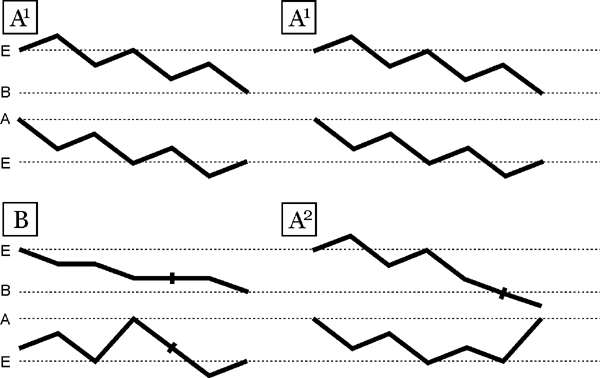
Note that zigzag diagrams and chord charts should hopefully ‘cue’ (start) a performance in your head – you should hear music playing when you look at them or read through them.
Other memory aids and music shorthands
Zigzag line diagrams are one technique to help you memorize music. You can apply it in your piano keyboard lessons to any melody or chord sequence bass line you really need to have secure in your head.
Other memory aids include chord charts and lead sheets. You generally have a chord chart there in front of you to play from – it’s half-way to memorising completely. A lead sheet is a chord chart with the melody written out on it.
For classically trained pianists learning the Pyramids Variations, these various memory aids are offered especially to help break the ‘dependency on the dots’ which stifles creativity.
You will find more types of musical shorthand in the Musicarta material – different ways of representing performance which help the music ‘sink in’ so you can play freely without written-out music.
There is 'top, middle, bottom' analysis, which shows how a simple chord can be broken up to make a classic right hand pop/rock sound.
There is 'left, right, together' analysis, a very efficient way of representing and learning syncopated two-hand patterns.
Advanced chord symbols contain lots of information about the notes being used at a particular point in time.
These are all helpful ways of remembering a performance. They are quicker than actually writing down the notes, and give the musician more responsibility and more musical freedom. If you have a way of jotting down musical ideas that works for you, stick with it and develop it.
This is the end of the Memorising module. Link back to the Musicarta home page for more exciting free
piano keyboard lessons
or jump back to one of the Pyramids Variations lessons (same window) using these links, and put your new memory skills into practice!
Thank-you for visiting Musicarta.com. Please come again soon!
Enjoy this page? Please pay it forward. Here's how...
Would you prefer to share this page with others by linking to it?
- Click on the HTML link code below.
- Copy and paste it, adding a note of your own, into your blog, a Web page, forums, a blog comment,
your Facebook account, or anywhere that someone would find this page valuable.
